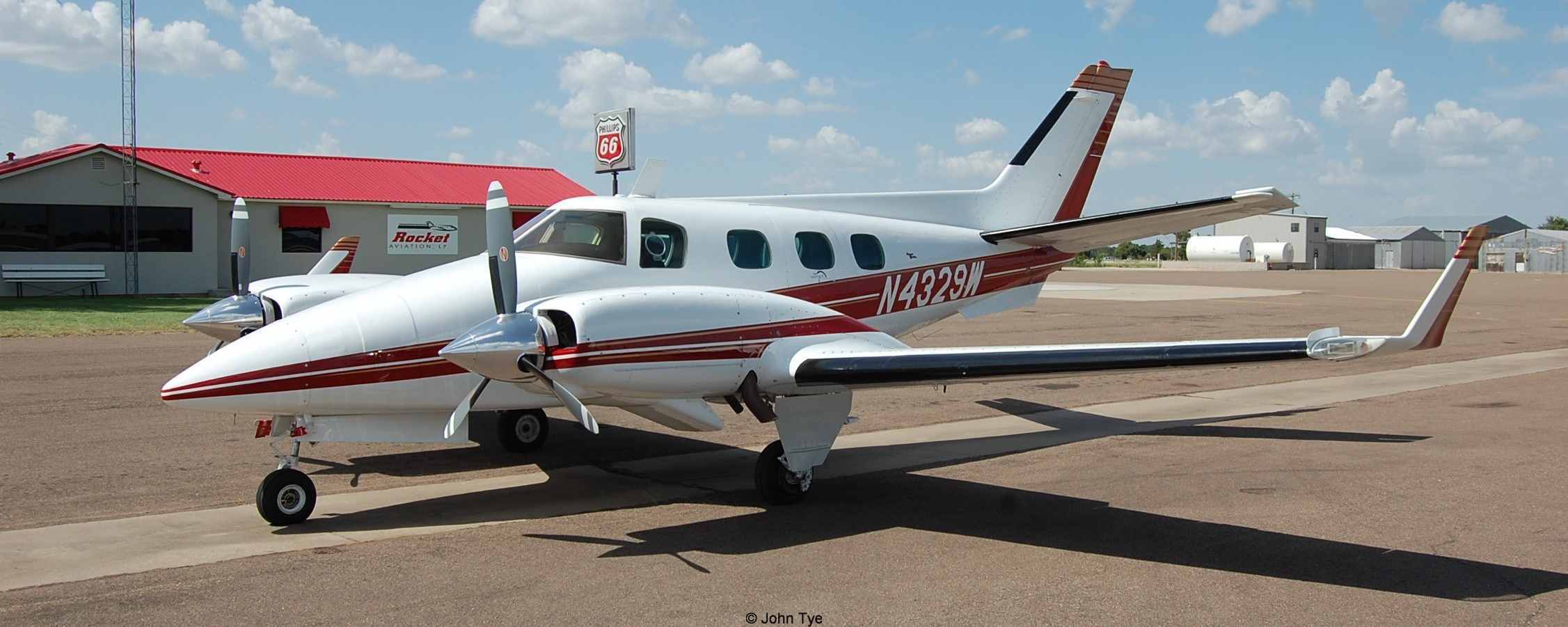History of the Beechcraft Duke
The Model 60 design concept evolved from a need for a new medium twin. The airplane was to offer a new profile with swept-back styling of the empennage, luxurious interiors, cabin pressurization, turbocharged engines and optional air conditioning. The Lycoming engines selected for the Duke were designed with turbochargers as an integral part (rather than a bolt-on accessory) to provide high altitude performance and maximum engine reliability. The same proven landing gear used on the Bonanza and Baron airplanes was strengthened and incorporated into the Model 60 design.
The production airplane utilized such modern engineering and construction method as chemical milling of skins to remove weight without reducing strength, metal bonding and honeycomb stiffening for light weight strength in areas of high stress, magnesium skins used in the empennage, and extensive use of flush riveting to provide an aerodynamically "clean" airplane.
The production flight tests began In December of 1966 and the first Duke 60 was delivered in August of 1968. The Duke soon proved to be the best performing, lowest priced, IFR equipped, pressurized twin available for the times.
The Duke Model A60 was introduced in March of 1970 at airplane serial number P-127. New interiors, cabin and cockpit appointments and exterior changes were added. Effective P-144, new turbocharger assemblies and exhaust ducting were added to improve efficiency and service life. Approximately 246 production model 60/A60 airplanes were delivered to customers.
The Duke B60 was introduced in October at 1973 at airplane serial P-247. This third generation of the Duke series aircraft incorporates the following changes: new exterior paint stripe, replacement of the cabin sidewall panel consoles and moving the third and fourth seats outboard to provide more width in cabin aisle. The instrument panel glare shield was mounted in a lower position to provide greater visibility. The pilot and copilot seat tracks were lengthened to provide, 1 to 1 1/2 inches additional aft travel of the seats. The cabin floorboards were lowered approximately 2 inches in the area directly in front of the fifth and sixth seats. This flatter floor provided improved ease of entry. The pressurization valves were relocated to the aft side of the pressure bulkhead. New interior appointments included a flush mounted cabin table and choice of interior carpets and upholstery fabrics.
The popular Duke B60 took on new dimensions of performance and a new look in October of 1975. The new developments in air pressurization systems and controllers Identical to the C90 King Air were incorporated in the Duke. Effective at P-385 and after the 1976 B60 featured a second optional fuel system increasing the total usable fuel capacity to 232 gallons and the range of the Duke by 20% at 68% power at FL 250.
In 1976 one of the Duke's direct operating costs was decreased 25%. This was achieved by increasing the TBO for the Lycoming TIO-541-E1C4 engine by 400 hours. Extensive testing with Dukes in the field and over 20 significant engine improvements since its first flight in 1966 gave Lycoming the proven confidence to increase the recommended TBO to 1600 hours.
In 1917, new developments included fuel sight gages with the long range fuel option, new cruise performance charts and the Collins Micro-line computerized avionics package, now standard equipment in the Duke.
The 1978 line included the quietest cabin sound level ever offered due to redesigned pressurization airflow and totally new soundproofing material used on the aft bulkheads and enclosures. Added comfort in the Duke was assured by the redesigned armrests and larger seats. The new wider aisle space provides better accessibility to the cockpit areas as well as convenience to passengers. Further ease of maintenance was provided for by the addition of two economical (12 volt batteries for longer life and lower maintenance cost.
A two-place couch replaced the fifth and sixth seats in 1980 and added 7 inches to the width of the rear seat area. Sidewalls were scooped out to provide an additional 2 Inches more elbow room and the armrests include a hydraulic lock so each seat back may be infinitely adjusted. A storage area was provided under each seat.
For 1981 the process of selective refinement of the Duke was continued with the addition of two fresh air/air conditioning vents in the cockpit. A King Air expansion valve with greater capacity was added to the air conditioner system which greatly reduces the temperature of the air. Also, the thermostat was placed higher up on the cabin sidewall to allow for more accurate temperature
